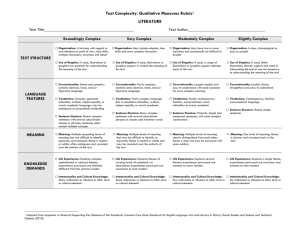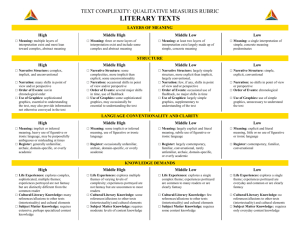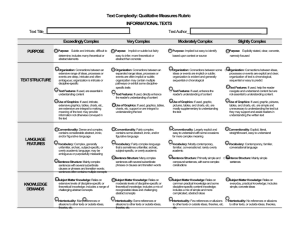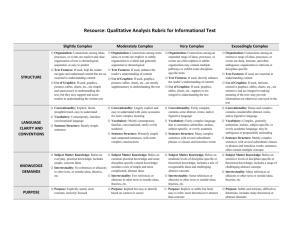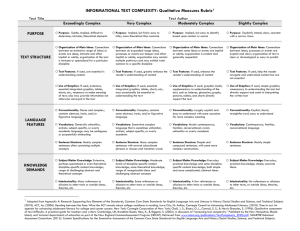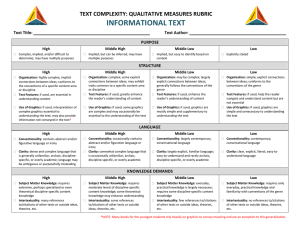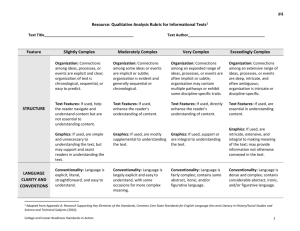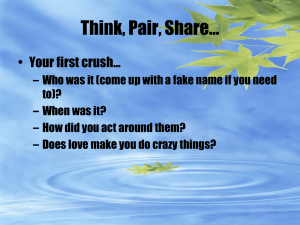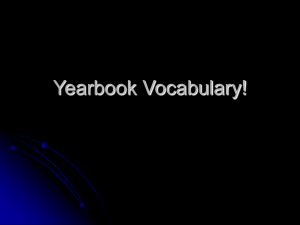Literature Text Complexity Rubric
advertisement
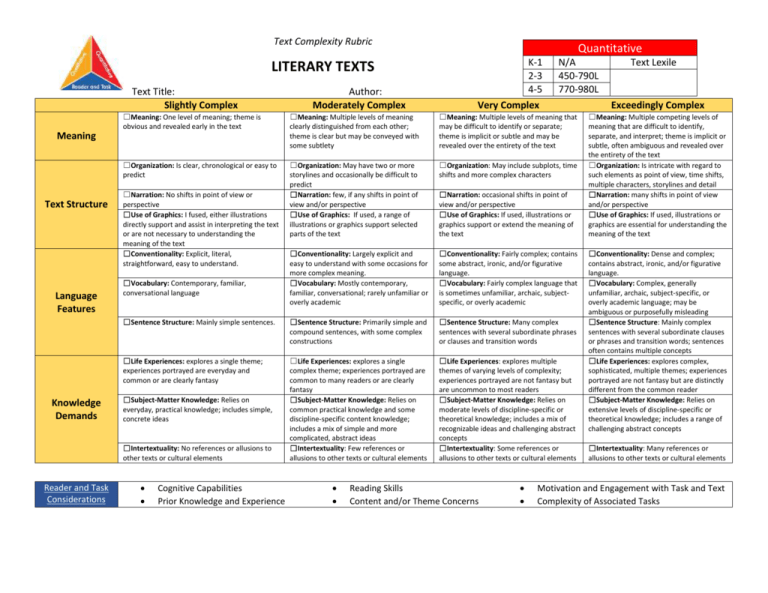
Text Complexity Rubric LITERARY TEXTS Text Title: Slightly Complex Language Features Knowledge Demands N/A 450-790L 770-980L ☐Meaning: Multiple levels of meaning clearly distinguished from each other; theme is clear but may be conveyed with some subtlety ☐Meaning: Multiple levels of meaning that may be difficult to identify or separate; theme is implicit or subtle and may be revealed over the entirety of the text ☐Organization: Is clear, chronological or easy to predict ☐Organization: May have two or more storylines and occasionally be difficult to predict ☐Narration: few, if any shifts in point of view and/or perspective ☐Use of Graphics: If used, a range of illustrations or graphics support selected parts of the text ☐Organization: May include subplots, time shifts and more complex characters ☐Conventionality: Largely explicit and easy to understand with some occasions for more complex meaning. ☐Vocabulary: Mostly contemporary, familiar, conversational; rarely unfamiliar or overly academic ☐Conventionality: Fairly complex; contains some abstract, ironic, and/or figurative language. ☐Vocabulary: Fairly complex language that is sometimes unfamiliar, archaic, subjectspecific, or overly academic ☐Sentence Structure: Mainly simple sentences. ☐Sentence Structure: Primarily simple and compound sentences, with some complex constructions ☐Sentence Structure: Many complex sentences with several subordinate phrases or clauses and transition words ☐Life Experiences: explores a single theme; experiences portrayed are everyday and common or are clearly fantasy ☐Life Experiences: explores a single complex theme; experiences portrayed are common to many readers or are clearly fantasy ☐Subject-Matter Knowledge: Relies on common practical knowledge and some discipline-specific content knowledge; includes a mix of simple and more complicated, abstract ideas ☐Intertextuality: Few references or allusions to other texts or cultural elements ☐Life Experiences: explores multiple themes of varying levels of complexity; experiences portrayed are not fantasy but are uncommon to most readers ☐Subject-Matter Knowledge: Relies on moderate levels of discipline-specific or theoretical knowledge; includes a mix of recognizable ideas and challenging abstract concepts ☐Intertextuality: Some references or allusions to other texts or cultural elements ☐Narration: No shifts in point of view or perspective ☐Use of Graphics: I fused, either illustrations directly support and assist in interpreting the text or are not necessary to understanding the meaning of the text ☐Conventionality: Explicit, literal, straightforward, easy to understand. ☐Vocabulary: Contemporary, familiar, conversational language ☐Subject-Matter Knowledge: Relies on everyday, practical knowledge; includes simple, concrete ideas ☐Intertextuality: No references or allusions to other texts or cultural elements Reader and Task Considerations K-1 2-3 4-5 Very Complex ☐Meaning: One level of meaning; theme is obvious and revealed early in the text Meaning Text Structure Author: Moderately Complex Quantitative Cognitive Capabilities Prior Knowledge and Experience ☐Narration: occasional shifts in point of view and/or perspective ☐Use of Graphics: If used, illustrations or graphics support or extend the meaning of the text Reading Skills Content and/or Theme Concerns Text Lexile Exceedingly Complex ☐Meaning: Multiple competing levels of meaning that are difficult to identify, separate, and interpret; theme is implicit or subtle, often ambiguous and revealed over the entirety of the text ☐Organization: Is intricate with regard to such elements as point of view, time shifts, multiple characters, storylines and detail ☐Narration: many shifts in point of view and/or perspective ☐Use of Graphics: If used, illustrations or graphics are essential for understanding the meaning of the text ☐Conventionality: Dense and complex; contains abstract, ironic, and/or figurative language. ☐Vocabulary: Complex, generally unfamiliar, archaic, subject-specific, or overly academic language; may be ambiguous or purposefully misleading ☐Sentence Structure: Mainly complex sentences with several subordinate clauses or phrases and transition words; sentences often contains multiple concepts ☐Life Experiences: explores complex, sophisticated, multiple themes; experiences portrayed are not fantasy but are distinctly different from the common reader ☐Subject-Matter Knowledge: Relies on extensive levels of discipline-specific or theoretical knowledge; includes a range of challenging abstract concepts ☐Intertextuality: Many references or allusions to other texts or cultural elements Motivation and Engagement with Task and Text Complexity of Associated Tasks
